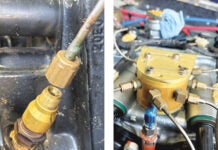 Engine controls should be mounted properly to the engine, not the engine mount tubes, and they should be secured with the proper attachments. The safety wire and Adel clamps seen here are not proper.
Engine controls should be mounted properly to the engine, not the engine mount tubes, and they should be secured with the proper attachments. The safety wire and Adel clamps seen here are not proper.
© 2025 Firecrown Media Inc. All rights reserved. ® KITPLANES is a registered trademark of Firecrown Media Inc.















I love when we get to see real examples of unairworthy stuff. Its really helpful in knowing what to look for, and it helps in understanding WHY the “proper” method is proper, by showing us what could go wrong when you don’t do it the proper way.
But, it really needs to also include examples of the Right way to do it. When you show examples of an unairworthy condition, please also show what it should look like had it been done properly. Don’t just say, “They should be secured with the proper attachments.”. Well, what is proper in this case? Which attachment method should be used?
Mike S. has a valid point. As a novice, I have learned a great deal from reading Vic’s books, articles & following his videos. I’d love to learn more. Should Vic elect to incorporate Mike’s tip in his presentations; there is little doubt that my skill-set will increase substantially. Thank you.
An add-on to Mike’s point: citing sources. Simply saying something is improper only carries the weight of your own opinion, whereas citing a specific source (like the 43.13, FARs, standard practices, manufacturer guidance, ADs, etc) means not only can the people who read your article do it right on their airplanes, but they can confidently pass the knowledge forward to others, too. Aviation safety shouldn’t rely on a game of telephone.
Mike & Barry, thanks for the input. I hear you. There is not room for showing the “right”way to fix these things in the little “unairworthy” feature box. I do try to show the right ways in some of my columns and books. Steve, I say humbly that I think I have enough experience and credibility across the AB world to recognize “unairworthy” things without having to cite specific sources. Most of these are quite obviously wrong, or could cause problems, whether immediately or at some future date. My intent is to help prevent failures and increase the safety aspect of AB aviation by bringing awareness to repetitive poor practices or poor workmanship. As an example, in the case of the missing fuel pump overflow tube, I have at least 5 pictures of this problem on different aircraft this year alone. So, I’m pretty confident there are more of them out there.